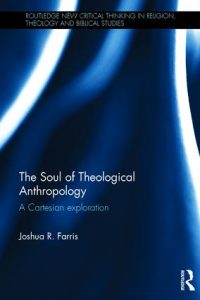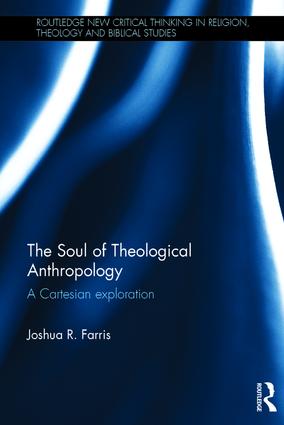Joshua R. Farris. The Soul of Theological Anthropology: A Cartesian Exploration. London, UK: Routledge, 2017. pp. 198. $119.96, hardback. $38.47, ebook.
Joshua R. Farris (Ph.D., University of Bristol) is Assistant Professor of Theology at Houston Baptist University, School of Humanities, The Academy and The Honors College, in Houston, TX. He is also a member of the Department of Theology and is Director over Trinity School of Theology.
Nearly 30 years ago, John W. Cooper wrote and published his widely read theological defense of substance dualism and the doctrine of the intermediate state: Body, Soul, and Life Everlasting. To this day, when one researches Christian accounts of the afterlife and attendant accounts of the human person, Cooper’s work is ubiquitous. Indeed, Body, Soul, and Life Everlasting has been something of the “gold standard” by which all defenses of the doctrine of the intermediate state and a theological defense of substance dualism have been measured. By my lights, that reign ends with the publication of Joshua Farris’s book, The Soul of Theological Anthropology. Farris is clear that his theological account of the human person “is motivated and influenced by John Cooper’s . . . work” and that he intends to “take some of Cooper’s conclusions forward” (p. 6). To my mind, Farris accomplishes what he sets out to do. Indeed, so I say, Farris’s monograph should be the text to which one appeals when one wants the most cutting-edge, thorough, and clear theological defense and construction of a substance dualist anthropology and doctrine of the intermediate state.
Setting his book out in four parts, Farris aims to provide a theological defense of and a constructive account for Cartesian substance dualism. By ‘Cartesian substance dualism,’ Farris means a particular class of “person-body substance dualism” that is “a broad category of substance dualism that describes persons as strictly identical to souls (i.e., an immaterial concrete part) or supervening on souls in contrast to bodies” (p. 2). The idea is that specifically Cartesian dualism suggests that persons are not composite entities. They are (or supervene on) souls. On a Cartesian account, a human person’s body is, to use a modal term, accidental to her. It is not required for the person’s identity or life. In the contemporary literature, this sort of view of human persons is attacked by philosophical, theological, and scientific arguments. In light of this, Section 1 of the book offers a number of preliminary philosophical and natural theological questions to begin countering some of the contemporary arguments. Moreover, in the second chapter of Part 1, Farris engages with a number of strictly theological and biblical critiques. This part of the book is useful for clearing away some of the conceptual clutter before Farris can begin to build his constructive proposal, which he begins in Part 2.
Part 2 (chapters 3-5) begins his constructive work. Here he provides a model of the soul’s creation that he calls “emergent creationism” (p. 76ff). What Farris attempts to do in these chapters is admirable; he interacts with leading philosophy of mind literature vis-à-vis the mind/soul’s interaction with the body, what that might tell us about from where the soul/mind comes, and also interacts with various streams of thought in Christian tradition (e.g., creationism and traducianism). Farris’s emergent creationism (EC), blends William Hasker’s emergent substance dualism with traditional notions of creationism (the thesis that God specifically and unilaterally creates a soul for each human body. Traducianism is the thesis that God created one soul, viz., Adam’s, from which all other souls descend). In sum, Farris’s EC suggests that, at the point at which a particular human body’s potentiality for interacting with an immaterial mind emerges, God creates a human soul/mind fit specifically for that body. The body’s being ready to receive a soul is thus a necessary condition for the soul’s being created for it. The necessary condition for the soul’s union with the body emerges with the body’s fitness for being ensouled. Helpfully, EC avoids having to explain how a non-physical entity (e.g., a soul) could emerge as a product of material/physical causes (i.e., material/physical causes are not a sufficient condition for the soul’s coming to be on Farris’s account as they are, for example, on Hasker’s). It also provides a ready-to-hand explanation for why souls and bodies are linked.
Parts 3 and 4 (chapters 6-9) of the work are a more strictly (but not solely) theological analysis of Cartesian dualism and EC. And, aside from the development of EC, I think Part 3, in particular, is the most valuable contribution of Farris’s work. For, taking EC in hand, he provides new ways for thinking about the transmission of original sin/guilt from Adam to Adam’s progeny (including you and me). Says Farris: “a story could be told that allowed for the direct transmission of original sin . . . because of the intimate relationship of souls to bodies and souls to other souls connected through one long interconnected biological chain” (p. 126). Given EC, there is meant to be a more natural accounting for why a human soul and its human body are linked, and, as such, why there is a certain sort of biological explanation for a soul (and, with the biological explanation, a purported hereditary line to Adam’s original guilt).
Chapters 7-9 provide an account for afterlife that attempts to give reasons for a theologian to affirm the intermediate state, the Beatific Vision, and the necessity of the bodily resurrection. Here Farris provides some nuanced and novel Cartesian approaches that help Cartesianism sit more comfortably in Christian theology than some might initially think is possible. One feature of his version of Cartesianism is that souls are specifically human souls; they are meant to be united to human bodies. Because of the EC account, Farris is more able to tie a human soul with a human body, thus giving an account for why a human should be embodied in the resurrection than other dualist views might. To my mind, any attempt to strengthen the Christian’s reliance on the hope of resurrection is a good attempt. Moreover, one of the strengths of this section, and the book writ large, is that Farris is able to interact with contemporary leading biblical scholars (e.g., N. T. Wright). This too helps Farris’s book surpass Cooper’s, even if this is a matter of historical coincidence (i.e., the research just was not available 30 years ago).
Now, I have published elsewhere a number of reasons for thinking that substance dualism is either false or unmotivated for Christian theology. I will not rehearse all of those reasons here. What I will say, though, is that, even though I think this book is a terrific effort and a contribution to the field that surpasses Cooper’s well-attested book, it still does not provide clear enough reasons to think that bodily resurrection is not at all superfluous for Christian hope. On Farris’s account, one can be denuded of one’s body and still exist in the Beatific Vision (an incredibly great state of existence). So, the body is superfluous for the Beatific Vision. To be clear, Farris (as well as Cooper and others) suggest that the bodily resurrection is of vital importance. But, it is not clear, so I say, why the resurrection is of vital importance in Christian thinking and hope. For, if there were no bodily resurrection, given Farris’s account, one would still be in the Beatific Vision. But this kind of conclusion is not, in my view, fitting with what the Bible suggests is the all or nothing hope the Christian should place on God’s bodily resurrecting humans (and redeeming his material creation). To wit: “if there is no resurrection of the dead . . . then our preaching is in vain and your faith is in vain” (1 Cor 15:13-14). I, for one, desperately wish for a dualist to engage specifically with this sort of critique. I desire a clear explanation for why someone in the Beatific Vision that is missing an accidental feature of herself (e.g., her body) would so much as care that she is missing it, let alone be in such a state that Paul suggests, were she left there, she would be “of all people most to be pitied” (1 Cor 15:18). Though Farris examines 1 Corinthians 15 (pp. 139-140), I think it is entirely too cursory and simply does not deal with the logic of the argument.
My own position on the matter notwithstanding, and a few other reservations I haven’t the space to address, this book is the new leader in the field for a theological defense and construction of a substance dualist anthropology and a doctrine of the intermediate state. For upper level undergraduate students and graduate students interested in theological anthropology and life after death, this is now a “go-to” resource. Though it is technical in places, the patient student should be able to navigate its arguments. Moreover, I think that the book’s attention to theological, philosophical, biblical, and scientific detail is a model for how up-and-coming theologians and Christian students should approach their work. This book is an object lesson in doing good theology. So, in the same way that Cooper’s work peppers the discussion to date, I hope that Farris’s work will do likewise. It should.
James T. Turner, Jr.
Fuller Theological Seminary





